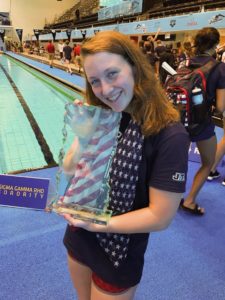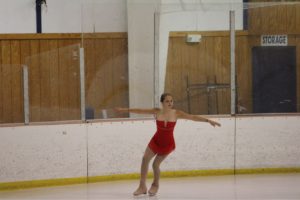Madison Homovich
 Walking into the Root Cellar Cafe, Woods Charter senior Madison Homovich exudes her status as a dedicated swimmer. Wearing a Team USA jacket, memorabilia from competing in the sixth FINA World Junior Swimming Championships, Homovich has goggle tan lines around her eyes, clear evidence of the time she puts into training.
Walking into the Root Cellar Cafe, Woods Charter senior Madison Homovich exudes her status as a dedicated swimmer. Wearing a Team USA jacket, memorabilia from competing in the sixth FINA World Junior Swimming Championships, Homovich has goggle tan lines around her eyes, clear evidence of the time she puts into training.
In 2017, Homovich qualified to be on the USA National Junior Team. She competed at the World Junior Swimming Championships in Indianapolis, swimming the 200m butterfly and 400m medley events against competitors from all over the world. In order to qualify for the national team, swimmers must be among the top ranked athletes in the world for their Olympic event.
At the world championships, Homovich placed fifth in the women’s 400m medley finals, ranking as the top USA contender. In the women’s 200m butterfly, Homovich again finished as the top USA swimmer, ranking 10th overall, just 0.24 seconds away from making it to the finals for the event.
Moving from Pennsylvania at the age of seven, Homovich transferred to Perry Harrison and joined the North Carolina Aquatic Club (NCAC). From there, she transferred to the Marlins of Raleigh on North Carolina State’s campus, where she developed a drive to train and compete with her newfound talent.
“My favorite part about swimming is training hard,” Homovich said. “I know that a lot of people don’t like to hurt when training, but that’s kind of the main reason I swim: because I feel so accomplished after a good practice.”
She trains every day except Sunday, putting in four and a half hours on Monday, Wednesday and Friday, two hours on Tuesday and Thursday and four hours on Saturday. According to Homovich, her training schedule has paid off, getting her ready for the longer races that she swims.
“You work different energy systems depending on the length of your race, but with mine, [training is] definitely pretty grueling,” Homovich said.
Training paid off for Homovich in more than just one way. She earned a scholarship from the University of Georgia, a Division I school and her top pick, which she will attend in the fall.
“I signed my National Letter of Intent, so everything is official now,” Homovich said. “I’m just really excited; I have a lot of friends going there with me that I’ve met from meets, and I think we’re going to have a lot of fun.”
Though Homovich didn’t make the cut for the Olympics this year, she says that doesn’t rule it out as a future possibility.
“Ever since I was a little kid, I’ve wanted to make the Olympic team,” Homovich said. “Now, I guess I’m just seeing where it takes me. Obviously I would really like to make it to an Olympic team, and that’s something that I want to work towards, but I want to enjoy my life and enjoy swimming as much as possible.”
Kendall Sutton
 Even to those who know junior Kendall Sutton best, her former life as an ice skater is a little known fact.
Even to those who know junior Kendall Sutton best, her former life as an ice skater is a little known fact.
Sutton began skating at the age of seven, taking lessons as a leisure activity and discovering a passion for the sport that led her to train and compete for several years.
“I started figure skating because I went to a friend’s birthday party and just really enjoyed it,” Sutton said. “It was all me pushing for it. I asked my mom to give me lessons, and my parents slowly started to support me wanting to skate.”
Sutton quickly outgrew those lessons, beginning to work one-on-one with a coach six days a week, morning and afternoon. Her coach urged her to compete throughout her eighth grade year and the summer before high school. According to Sutton, these competitions were never her favorite part of ice skating.
“Honestly, practices were always the most fun for me—spinning, jumping and just joking around with it,” Sutton said. “I didn’t really like when I had to get serious for competitions.”
Sutton’s training consisted of spending nine week periods at different skating levels before she could rise to the next.
“As you get higher, you have to start going to testing,” Sutton said. “You get on the ice, and you have to show that you can be technical with your footwork, what moves you can do and what jumps and spins you’re capable of before they say you can pass to the next level.”
Sutton rose to the junior level, right before the Olympic senior level, before quitting her freshman year. She gives many reasons for why she stopped ice skating, including the rising price that comes as skaters get older and more involved.
“As you go higher up, boots begin to become more expensive with Italian leather, different padding and separate blades,” Sutton said. “When you start out, it’s like $60 for two pairs of boots with these crappy blades, but when I got to where I was, it started to be $2,000 for the boots and then more for the blades, and then to put them together and get them fitted was even worse.”
Another reason Sutton decided to end her skating career was the growing amount of time she had to spend on the ice.
“I thought about the Olympics for a long time because I was working my way up so fast,” Sutton said. “But my mom knows someone who has kids at the Olympic level, and they train seven days a week for 10 hours a day and do online school, so they don’t have time to have normal lives. Eventually I just realized, with that in mind, that I didn’t want to do it.”
Despite having to stop competing, Sutton misses this part of her life.
“I still don’t like that I stopped,” Sutton said. “I miss being athletic and having something that I’m dedicated to. Sometimes I wish I could go back and do it all over again, but I just do not have the time on my hands.”
– By Lanna Read
